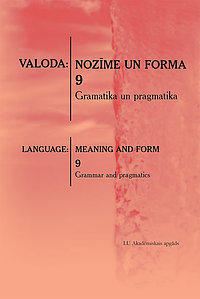Lithuanian anticausative verb triads: form, semantics and functions
Lithuanian anticausative verb triads: form, semantics and functions
Author(s): Giedrė JunčytėSubject(s): Syntax, Semantics, Pragmatics
Published by: Latvijas Universitātes Akadēmiskais apgāds
Keywords: verb triad; n/sta-present; middle marked verb; causal/noncausal; anticausative; body action middle;
Summary/Abstract: In Lithuanian, a considerable number of infixed/sta-presents, causal verbs (basic or with the suffix -(d)inti/-(d)yti), and middle marked verbs form the so-called verb triads (cf. Ambrazas 1997, 231; see also Geniušienė 1987). Functionally these triads are not homogeneous because the first and the third members may be either synonyms or not, depending on the function of the middle marker of the triad’s third member, which may be a body action (indirect/reciprocal/cognition/emotion) middle (e.g. lenktis ‘bend (MM)’, as in Aš lenkiuosi ‘I bend (myself)’) or an anticausative (lenktis ‘bend (MM)’ = linkti ‘bend (INTR)’, as in Šaka lenkiasi/linksta nuo vėjo ‘The branch bends in (lit. from) the wind’). The subject aš ‘I’ in the former example is agentive and šaka ‘the branch’ in the latter example is nonagentive, therefore it is proposed here that the main defining property is agentivity (control, volition, animacy, see DeLancey 1984, 181) of the subject. This paper aims at characterising each of these triad types and defining the formal, semantic, and functional differences between them.
Journal: Valoda: nozīme un forma
- Issue Year: 2018
- Issue No: 9
- Page Range: 80-95
- Page Count: 16
- Language: English

